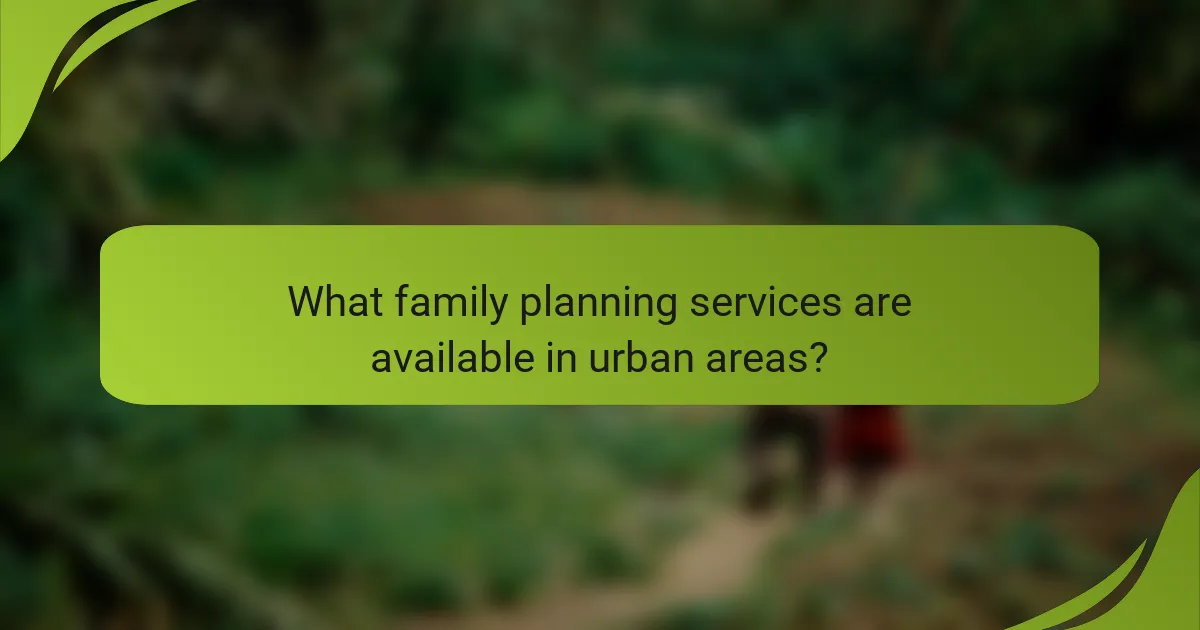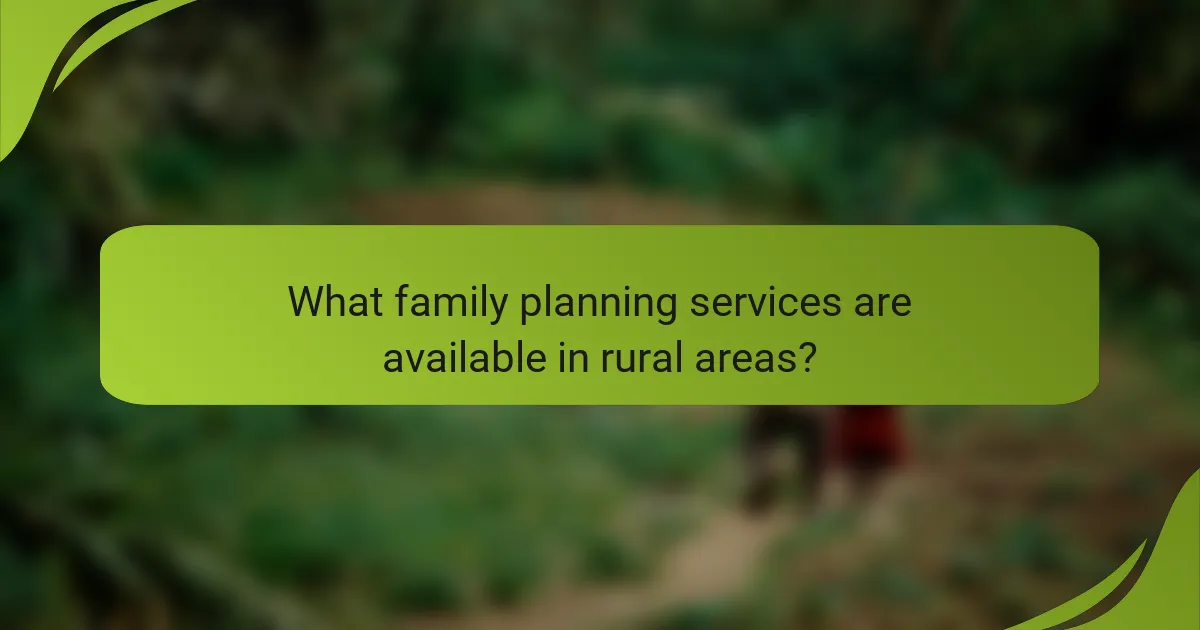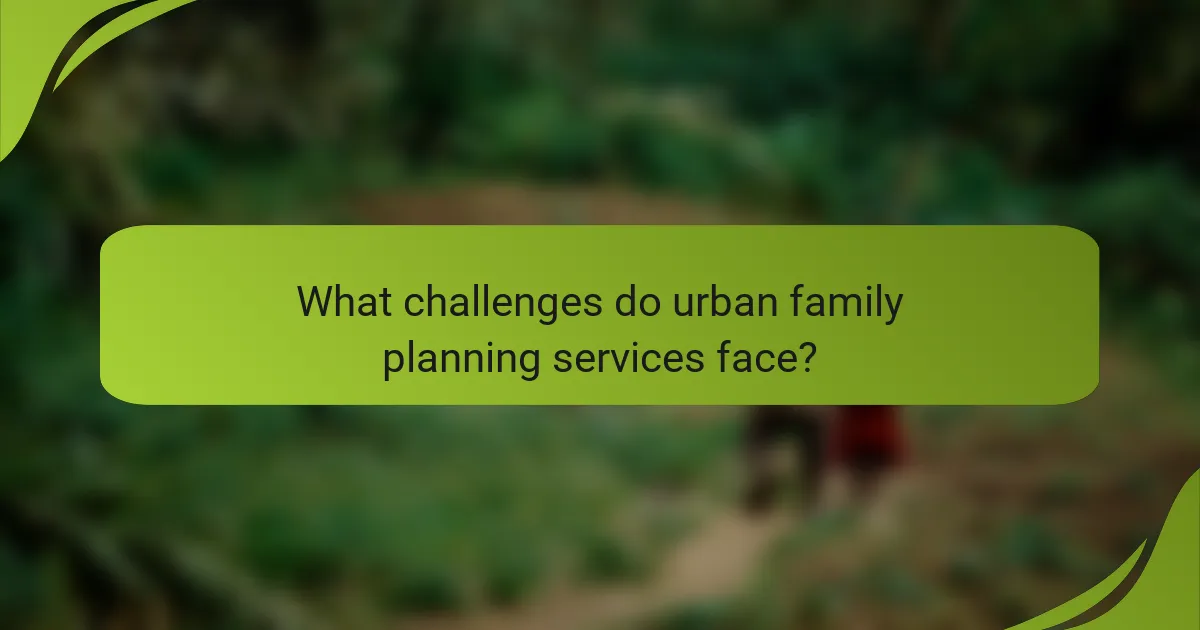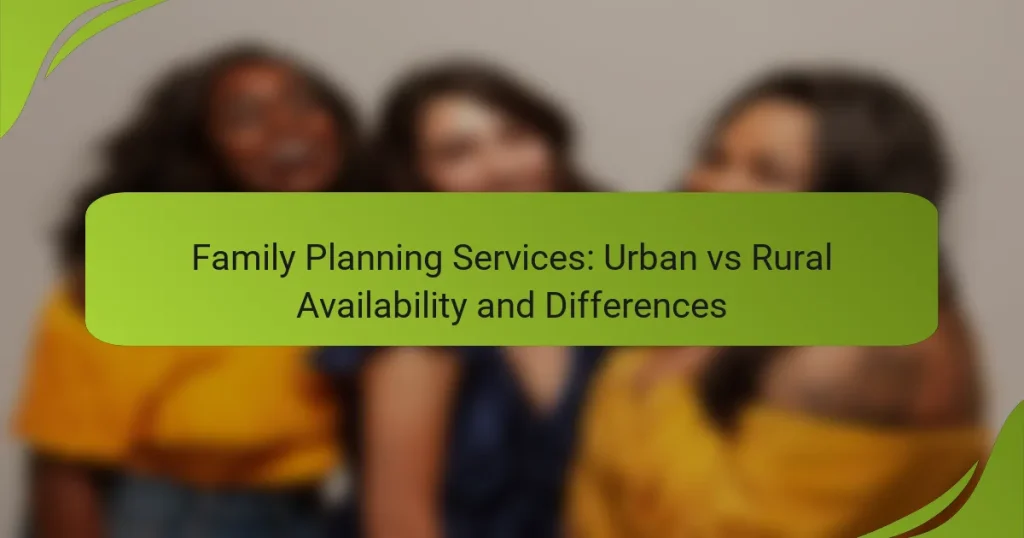Family planning services vary significantly between urban and rural areas, impacting accessibility and resource availability. Urban regions generally provide a broader spectrum of services, including comprehensive clinics and telehealth options, catering to diverse populations. In contrast, rural areas often rely on community health centers and mobile units, facing challenges such as limited access to specialists and fewer healthcare providers.

What family planning services are available in urban areas?
Urban areas typically offer a wide range of family planning services, including comprehensive clinics, public health programs, private healthcare options, and telehealth services. These services are designed to meet diverse needs and provide accessible reproductive health care to city residents.
Comprehensive clinics
Comprehensive clinics in urban settings provide a full spectrum of family planning services, including contraceptive counseling, STI testing, and reproductive health education. These clinics often operate under public health departments or nonprofit organizations, ensuring affordability and accessibility.
Many comprehensive clinics offer sliding scale fees based on income, making them a viable option for low-income individuals. They may also provide additional services such as prenatal care and referrals for more specialized treatments.
Public health programs
Public health programs in urban areas focus on promoting reproductive health and providing family planning resources to the community. These programs often include educational workshops, outreach initiatives, and partnerships with local organizations to enhance access to services.
Many public health programs are funded by government grants, which allows them to offer services at little to no cost. They may also provide free contraceptives and health screenings to eligible participants, making them an essential resource for urban populations.
Private healthcare options
Private healthcare options in urban areas include family planning services offered by private clinics and hospitals. These facilities often provide a more personalized experience and may have shorter wait times compared to public services.
While private healthcare can be more expensive, many providers accept insurance plans, which can help offset costs. It’s advisable to check with your insurance provider to understand coverage for family planning services before seeking care.
Telehealth services
Telehealth services have become increasingly popular in urban areas, allowing individuals to access family planning consultations remotely. This option is particularly beneficial for those with busy schedules or mobility challenges, as it provides convenience and privacy.
Many telehealth platforms offer services such as virtual consultations, prescription refills, and online access to educational resources. However, it’s important to ensure that the telehealth provider is licensed and follows local regulations to guarantee quality care.

What family planning services are available in rural areas?
Rural areas often have limited family planning services compared to urban settings, but several essential options are available. These services typically include community health centers, mobile health units, and may face challenges such as limited access to specialists.
Community health centers
Community health centers are vital for providing family planning services in rural areas. They offer a range of reproductive health services, including contraceptive counseling, pregnancy testing, and STI screenings. These centers often operate on a sliding fee scale, making them accessible to low-income individuals.
In many cases, community health centers are the primary source of healthcare for rural residents, ensuring that essential family planning resources are available. They may also provide educational programs to raise awareness about reproductive health options.
Mobile health units
Mobile health units serve as an innovative solution to reach underserved populations in rural areas. These units travel to various locations, offering family planning services such as contraceptive distribution and health education. They help bridge the gap for individuals who may not have easy access to fixed health facilities.
Mobile units can be particularly effective during community events or in remote locations, providing flexibility and convenience. They often collaborate with local organizations to enhance outreach and ensure that services meet the specific needs of the community.
Limited access to specialists
Access to specialists in rural areas can be quite limited, impacting the availability of comprehensive family planning services. Residents may have to travel significant distances to consult with reproductive health specialists, which can deter them from seeking care. This barrier can lead to unmet needs for advanced family planning options.
To mitigate this issue, telehealth services are becoming increasingly important, allowing patients to connect with specialists remotely. However, not all rural areas have the necessary technology or internet access, which can further complicate the situation. It is crucial for rural residents to be aware of available resources and advocate for improved access to specialized care.

How do urban and rural family planning services differ?
Urban and rural family planning services differ significantly in terms of availability, access to resources, patient demographics, and healthcare provider density. Urban areas typically offer a wider range of services and resources due to higher population density, while rural areas may face challenges such as limited access and fewer healthcare providers.
Service availability
In urban settings, family planning services are generally more accessible, with numerous clinics and specialized facilities available. These services often include a variety of contraceptive options, counseling, and reproductive health education. In contrast, rural areas may have only a few clinics, which can lead to limited choices for residents.
For example, urban centers might provide advanced services like IUD insertions and fertility treatments, while rural clinics may primarily offer basic contraceptive methods. This disparity can affect the overall reproductive health of individuals living in these areas.
Access to resources
Urban populations typically have better access to educational materials, support groups, and online resources related to family planning. This access allows individuals to make informed choices about their reproductive health. In rural areas, however, resources may be scarce, and residents might rely on local health workers for information.
Additionally, transportation can be a barrier in rural regions, making it difficult for individuals to reach available services. Urban residents often have multiple transportation options, reducing the time and effort needed to access family planning services.
Patient demographics
Demographics in urban and rural areas can influence family planning needs and preferences. Urban populations tend to be more diverse, with varying cultural attitudes towards family planning, which can lead to a broader range of services being offered. Rural areas may have more homogenous populations, which can affect the types of services that are prioritized.
Moreover, urban residents often have higher education levels, which can correlate with increased awareness and use of family planning services. In contrast, rural populations may face challenges such as lower educational attainment and differing cultural beliefs that can impact their engagement with family planning.
Healthcare provider density
Healthcare provider density is typically much higher in urban areas, allowing for more specialized family planning services. This concentration of providers means that urban residents can often find a wider variety of healthcare professionals, including those specializing in reproductive health.
Conversely, rural areas often struggle with a shortage of healthcare providers, which can lead to longer wait times and limited service availability. This lack of providers can hinder access to essential family planning services, making it crucial for rural residents to seek out available resources proactively.

What challenges do urban family planning services face?
Urban family planning services encounter several challenges that hinder their effectiveness, including high demand, funding limitations, and significant health disparities. These factors can strain resources and impact the quality of care provided to individuals seeking family planning options.
High demand for services
In urban areas, the demand for family planning services often exceeds available resources. This high demand can lead to long wait times for appointments and limited access to essential services. For instance, clinics may struggle to accommodate the needs of diverse populations, resulting in unmet requests for contraceptive options and counseling.
To manage this demand, urban clinics can implement strategies such as extended hours, online appointment scheduling, and outreach programs to educate the community about available services. These measures can help alleviate pressure on facilities and improve access for those in need.
Funding limitations
Funding for urban family planning services is frequently constrained, impacting the quality and availability of care. Many clinics rely on government grants, which can fluctuate based on political priorities and budget allocations. This uncertainty can hinder the ability to hire qualified staff or maintain adequate supplies of contraceptives.
To navigate funding limitations, clinics can seek partnerships with non-profit organizations and private sector stakeholders. These collaborations can provide additional resources and support, allowing clinics to expand their services and reach more individuals effectively.
Health disparities
Urban family planning services often face significant health disparities that affect access and outcomes. Marginalized communities may experience barriers such as language differences, cultural stigma, and lack of transportation, which can prevent them from utilizing available services. These disparities can lead to higher rates of unintended pregnancies and poorer reproductive health outcomes.
Addressing health disparities requires targeted outreach and culturally competent care. Clinics should consider implementing community-based programs that engage with underserved populations, providing education and resources tailored to their specific needs. This approach can help bridge gaps in care and promote better health equity in urban settings.

What challenges do rural family planning services face?
Rural family planning services encounter several significant challenges that hinder access and effectiveness. These include transportation barriers, provider shortages, and limited awareness of available services.
Transportation barriers
Transportation barriers are a major obstacle for individuals seeking family planning services in rural areas. Many residents may live far from clinics, and public transport options are often limited or nonexistent. This can result in long travel times and increased costs, making it difficult for individuals to access necessary care.
To mitigate transportation issues, some rural health programs offer mobile clinics or partnerships with local organizations to provide transportation assistance. However, these solutions may not be widely available, leaving many without reliable options.
Provider shortages
Provider shortages significantly impact the availability of family planning services in rural regions. Many rural areas struggle to attract and retain healthcare professionals, leading to fewer clinics and longer wait times for appointments. This shortage can limit the range of services offered, such as contraceptive counseling and reproductive health education.
Efforts to address provider shortages include incentives for healthcare workers to practice in rural areas, such as loan repayment programs and competitive salaries. However, these initiatives may take time to implement and may not fully resolve the issue.
Limited awareness of services
Limited awareness of family planning services is a critical challenge in rural communities. Many individuals may not know what services are available or how to access them, often due to a lack of outreach and education. This can lead to underutilization of essential health resources.
Community engagement initiatives, such as informational workshops and partnerships with local organizations, can help raise awareness. Additionally, using local media channels to disseminate information can improve knowledge about available family planning services and resources.


